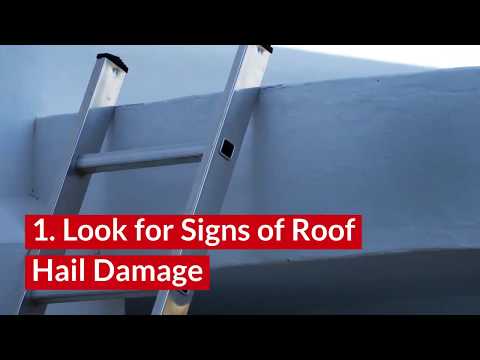In 2018, hailstorms caused over $10 billion worth of property damage. They’re responsible for the majority of storm-related insurance payouts.
Even so, many people underestimate the prevalence and destructive power of hail. When a hailstorm passes by overhead, is your roof safe? How do you even inspect or repair a damaged roof?
Hail damage roof repair doesn’t have to be complicated.
After a hailstorm, your roof could become severely damaged, allow water to leak into your home, or reduce the lifespan of your roof. This could cost you tens of thousands of dollars from your own pocket in repairs.
Don’t lose out on an insurance claim. Read our hail damage guide and prepare yourself before the next hailstorm strikes.
1. Look for Signs of Roof Hail Damage
There were 4,611 reports of hail in 2018 alone. No matter where you live, you should know how a hail-damaged roof looks.
Hail damage manifests differently depending on the type of roof. So how do you know if you should replace your roof?
From the top of a ladder — because you should never walk on your roof — look for the signs. Hail damage to roof shingles will likely strip them of their granular coating. The underlying fabric will be visible in a pockmarked pattern.
It’s easiest to spot hail damage on metal or vinyl roofing. Just look for dents and scratches.
Your roof will sustain damage based on the length and severity of the storm and also the condition and slope of your roof.
Unlike other roofs, flat roofs endure the largest impact from hailstorms. On sloped roofs, hail bounces off at an angle with reduced strength. Flat roofs don’t have that luxury, which is why it is important for flat roofs to have.
If a significant hailstorm passed but you haven’t spotted any signs of damage, you should still call an inspector. Whether your property is residential or commercial, leave that responsibility up to a trained professional.
Even if a roof appears to be fine in your eyes, it could have sustained serious damage underneath, or the signs of damage could be difficult to spot based on your roofing material.
Don’t leave these matters up to chance. A hailstorm will reduce the age of your roof and a single puncture will allow rainwater to leak in, leading to a slew of other damages and expensive repairs down the line.
2. Call an Adjuster
If you think your roof has been damaged by hail, your first point of contact is your insurance company. They will send an adjuster to inspect it.
Don’t wait too long to contact your insurance company. In general, you have about a year to file an insurance claim.
It’s recommended that along with an adjuster, you also call a nearby roofing company for additional inspection. If you receive two separate diagnoses, ask for a re-inspection.
Your insurance adjuster and the private inspector will perform an additional joint inspection to uncover the most accurate extent of the damages.
Re-inspections are extremely common. Sometimes, either the adjuster or the inspector isn’t adequately experienced. Other times, they may have simply performed the inspection before the damage became more evident.
After the inspection, your insurance company will notify you if any damages were discovered. In this case, they’ll offer an estimate for you to hire a crew and have your roof repaired.
3. Hail Damage Roof Repair
Has your roof been damaged by hail? Then it’s likely your insurance will be paying for the work. Now it’s time to find a roof repair company to do the job.
Avoid working with individuals who knock on your door following a terrible hailstorm. Many may provide terrible service or no service at all, and they’re looking to turn a quick buck from your insurance claim.
Instead, take your time and do your research. Your insurance company will give you an estimate. Rather than getting bids for the lowest price around, get the most out of your insurance coverage by hiring a quality team that fits your budget.
Unfortunately, this entire process can take about two to three months, starting with when you first call your insurance adjuster. Remember that if your home received significant roof damage, it’s likely that your neighbors have as well.
The local roofing companies will be quite busy for the next few months repairing the local community. However, once they finally start work on your roof, it will likely be repaired in only one to two days.
If you have a flat roof or are considering investing in an SPF roofing system, contact us for a free quote to see how we can help you!
4. Hail Proof Your Roof
Does this all seem like a bit too much? Preventing roof damage is the best way to avoid dealing with insurance adjusters and roof repairs.
For those who live in areas prone to hailstorms or reside in a building vulnerable to roof damage, such as those with flat roofs, upgrading the roof is often the best choice.
For buildings without shingles, such as flat roofs, consider sprayed polyurethane foam. An SPF roof system provides an insulating, protective layer for flat roofs.
One and a half inches thick, an SPF roof system can help shield your roof from damage and comes with a lengthy 15-year warranty.
Get More Tips from Roofing Experts
Severe storms can be scary. Hail damage roof repairs shouldn’t be. Roofs are one of the most important features of any building and are too often overlooked.
From insulation costs to water damage, the condition and maintenance of your property’s roofing could cost you thousands in energy and repair costs.
Learn how spray polyurethane foam roofs can save you time, energy, and money.
